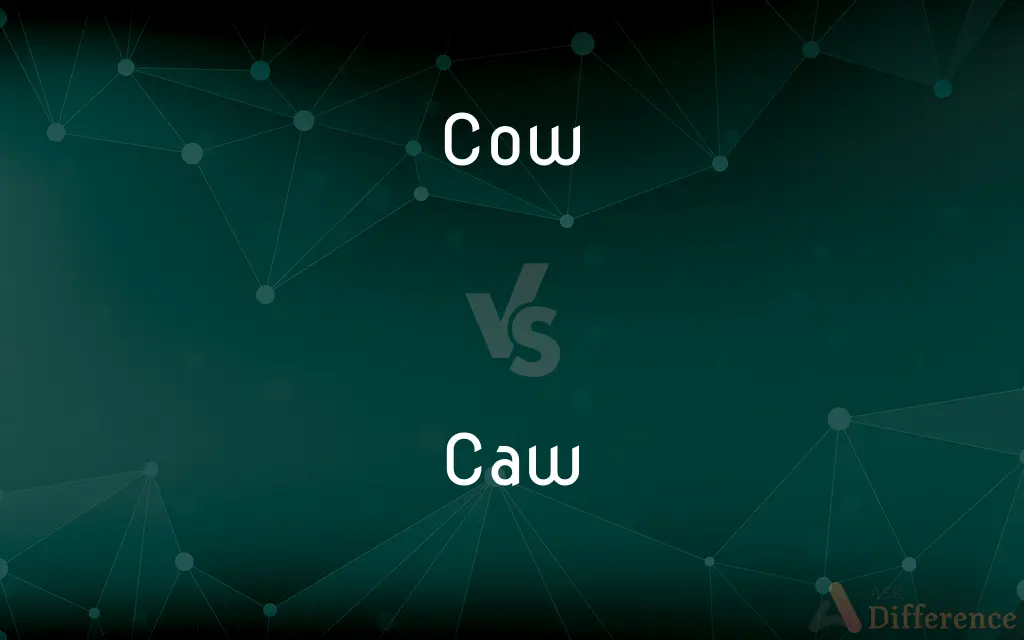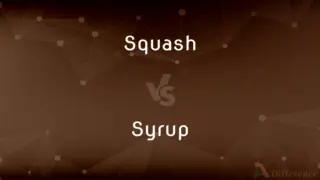Cow vs. Caw — What's the Difference?
Edited by Tayyaba Rehman — By Urooj Arif — Updated on March 13, 2024
Cow refers to a domesticated bovine animal, while caw is the harsh sound made by crows.

Difference Between Cow and Caw
Table of Contents
ADVERTISEMENT
Key Differences
Cows are large mammals farmed for milk, meat, and hides, known for their gentle nature and grazing habits. Caw, on the other hand, is associated with crows and ravens, serving as a means of communication among these birds.
While cows are integral to agriculture and economies, providing a range of products, cawing plays a role in the social structure and signaling within corvid species.
The physical presence and utility of cows contrast with the auditory nature of cawing, which signifies the presence or behavior of birds. These terms diverge completely in their application and relevance, one rooted in agriculture and the other in avian behavior.
Comparison Chart
Definition
A domesticated bovine animal, often kept for milk, meat, or as a work animal.
The harsh, raucous sound made by crows or ravens.
Category
Mammal, specifically bovine.
Sound or vocalization.
ADVERTISEMENT
Role in Nature
Agricultural and economic significance, providing dairy and meat products.
Communication among crows and ravens, indicating their presence or activities.
Characteristics
Large size, grazes on grass, gentle disposition.
Auditory signal, often perceived as harsh or loud.
Significance
Integral to many cultures for its contributions to agriculture.
Important for the social structure and behavior of corvid species.
Compare with Definitions
Cow
A large mammal farmed for its milk, meat, and hide.
The farmer's cow produces fresh milk every morning.
Caw
The characteristic call of crows and ravens, often loud and harsh.
The sound of a crow's caw echoed through the early morning fog.
Cow
The primary source of milk and dairy products for human consumption.
Dairy farms typically have a large number of cows to meet the demand for milk and cheese.
Caw
Used by crows to communicate with each other, signaling various behaviors or warnings.
The caw of a crow can indicate territorial presence or serve as an alert to others.
Cow
Known for their docile and calm behavior, making them suitable for farming.
Despite their size, cows are generally gentle creatures that enjoy grazing in the fields.
Caw
Recognizable and distinct, cawing can be heard over long distances.
Even from inside the house, the caw of the crow in the backyard was unmistakable.
Cow
In some cultures, cows hold significant religious and cultural symbolism.
In Hinduism, the cow is considered sacred and symbolizes life and the sustenance of life.
Caw
Plays a role in the complex social structure of corvids.
Crows use cawing to maintain social bonds and establish hierarchies within their groups.
Cow
An animal integral to farming and rural economies.
In many cultures, the cow is revered and plays a central role in agricultural practices.
Caw
The presence and frequency of cawing can indicate the health of crow populations and their environment.
An increase in cawing in the area could suggest a growing crow population or changes in their habitat.
Cow
The mature female of cattle of the genus Bos.
Caw
The hoarse raucous sound that is characteristic of a crow or similar bird.
Cow
The mature female of certain other large animals, such as elephants, moose, or whales.
Caw
To utter such a hoarse raucous sound.
Cow
To frighten or subdue with threats or a show of force.
Caw
The harsh cry of a crow.
Cow
(uncommon) Beef: the meat of cattle as food.
The only meat I eat is cow.
Caw
To make the harsh cry of a crow, rook, or raven.
Cow
(uncommon) Any bovines or bovids generally, including yaks, buffalo, etc.
Caw
A rendering of the vocalisation of a crow or other corvid.
Cow
(biology) A female member of other large species of mammal, including the bovines, moose, whales, seals, hippos, rhinos, manatees, and elephants.
Caw
To cry like a crow, rook, or raven.
Rising and cawing at the gun's report.
Cow
A woman considered unpleasant in some way, particularly one considered nasty, stupid, fat, lazy, or difficult.
Caw
The cry made by the crow, rook, or raven.
Cow
(mining) A chock: a wedge or brake used to stop a machine or car.
Caw
The sound made by corvine birds
Cow
To intimidate; to daunt the spirits or courage of.
Con artists are not cowed by the law.
Caw
Utter a cry, characteristic of crows, rooks, or ravens
Cow
The mature female of bovine animals.
Cow
The female of certain large mammals, as whales, seals, etc.
Cow
A chimney cap; a cowl
Cow
A wedge, or brake, to check the motion of a machine or car; a chock.
Cow
To depress with fear; to daunt the spirits or courage of; to overawe.
To vanquish a people already cowed.
THe French king was cowed.
Cow
Female of domestic cattle:
`moo-cow' is a child's term
Cow
Mature female of mammals of which the male is called `bull'
Cow
A large unpleasant woman
Cow
Subdue, restrain, or overcome by affecting with a feeling of awe; frighten (as with threats)
Common Curiosities
Is cawing unique to crows and ravens?
While cawing is most commonly associated with crows and ravens, other bird species may produce similar sounds.
How do cows contribute to agriculture?
Cows contribute significantly through dairy production, meat, leather, and even as work animals in some agricultural practices.
Can cows be found in the wild?
While cows are primarily domesticated animals, there are wild species of bovines, such as bison and buffalo, which share some characteristics with domestic cows.
Do crows use cawing for navigation?
Crows primarily use visual cues for navigation, but cawing can help maintain group cohesion during flight or signal locations.
Are cows revered in any cultures?
Yes, in some cultures, such as Hinduism, cows are considered sacred and are associated with various religious and cultural practices.
What products are derived from cows?
Milk, cheese, butter, yogurt, beef, leather, and even certain pharmaceuticals can be derived from cows.
Can the caw of a crow convey different messages?
Yes, variations in the cawing sound, frequency, and context can convey different messages or signals among crows.
Do cows have a social structure?
Yes, cows often form close social structures within herds, establishing hierarchies and forming bonds with other cows.
What distinguishes a cow from other bovine animals?
Cows are specifically female bovine animals, often referred to in the context of dairy production or as maternal figures within a herd.
How long has the domestication of cows been part of human history?
Cows have been domesticated for thousands of years, with evidence suggesting their domestication began around 10,000 years ago.
What role does cawing play in a crow's life?
Cawing is essential for communication, establishing territory, social interactions, and warning signals among crows.
Are all crows capable of cawing?
Yes, cawing is a common vocalization among all crow species, although the sound and frequency can vary.
Can the environment affect a crow's caw?
Environmental factors, such as urbanization, can influence the frequency and tone of a crow's caw, as they adapt to different surroundings.
What are the environmental benefits of cows?
When managed sustainably, cows can contribute to the maintenance of grasslands, support biodiversity, and participate in nutrient recycling through their grazing.
Is cawing heard only during specific times?
Cawing can be heard throughout the day, but it is often more noticeable during dawn and dusk when crows are more active.
Share Your Discovery

Previous Comparison
Squash vs. Syrup
Next Comparison
Empowerment vs. DisempowermentAuthor Spotlight
Written by
Urooj ArifUrooj is a skilled content writer at Ask Difference, known for her exceptional ability to simplify complex topics into engaging and informative content. With a passion for research and a flair for clear, concise writing, she consistently delivers articles that resonate with our diverse audience.
Edited by
Tayyaba RehmanTayyaba Rehman is a distinguished writer, currently serving as a primary contributor to askdifference.com. As a researcher in semantics and etymology, Tayyaba's passion for the complexity of languages and their distinctions has found a perfect home on the platform. Tayyaba delves into the intricacies of language, distinguishing between commonly confused words and phrases, thereby providing clarity for readers worldwide.
















































